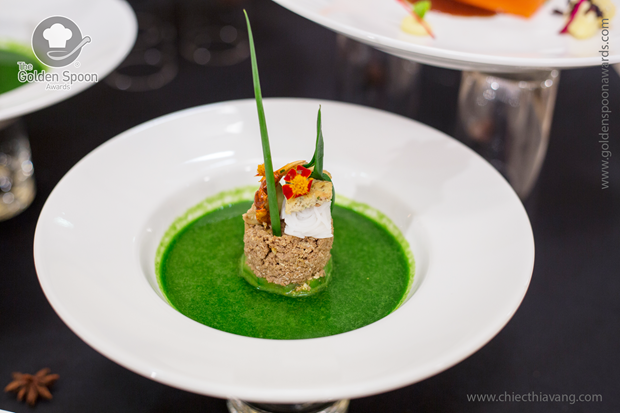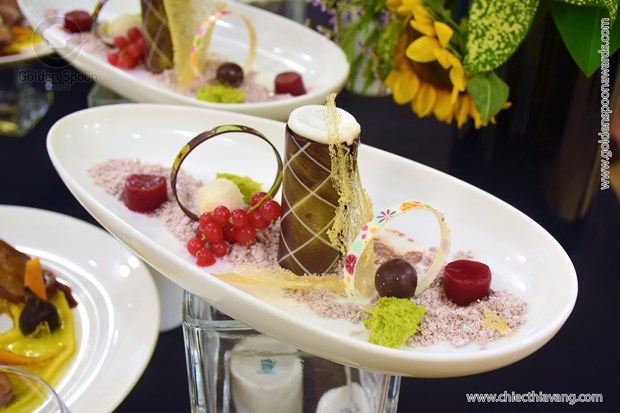The semifinal of Northern
regions attracted strong and potential representatives from renowned
restaurants, hotels and resorts. They were qualified from regional prelims of
Northern Central, Northern Highlands, Red River Delta and Ha Noi. The chefs had
created local signature recipes that harmonized with the mild weather of Ha Noi
autumn. Each and every participant put effort in performing their best skills
and showing their ultimate winning spirit for the grand final prize of one
billion dong worth and the prestigious cup for the super chef.
High-class menu, Western
style
Given the theme of Golden Recipe, all teams had the chance
to demonstrate their best cooking techniques, as well as show off their “secret
weapons” that had not been unveiled in the regional prelims yet. Besides those
confident in their “strong suit” and personal “maneuvers”, others took up
challenges with innovative recipes and cooking methods.
Battling for the very tickets
to the finale, despite time constraints for preparation (only two weeks), the
competing teams were very determined to win in the Golden Spoon Awards by
providing well prepared menu and utilizing diverse ingredients. There were even
new lavish costly ingredients hunted down from all over the world that made
their debuts in this competition, such as spanner crab, wagyu beef, scallop,
seaweed, octopus, Japanese soy bean, duck breast, foie gras and carneau, North
African rice, cold water shrimp, Spanish pork, Italian caviar, Korean lingzhi,
New Zealand lobster, stonefish, etc.
Among heavily invested menus with
luxurious imported ingredients, Naman Retreat Resort Da Nang’s (Team no. 77)
had held the judge panel and food lovers in awe when claimed theirs to “bring
international flavors to Vietnamese dining table”, from the grand symphony of
cold seafood as an entree (French lobster, Japanese octopus, Italian caviar,
cold water shrimp, New Zealand mussel) to Japanese wagyu beef with French foie
gras as meat main dish, and French carneau as poultry.
Aiming to “awake all senses”,
Naman Retreat Resort Da Nang had brought an exceptional gastronomical experience
to the judge panel. Not only did they ensure image (vision), smell (olfaction),
taste (gustation) and touch (tactioception), but also offered real seashells
for diners to actually listen to the sound of ocean while relishing the dish.
Besides, the team from the home of world records also creatively applied
new cooking techniques. Slow-cooking was highlighted to reserve natural flavors
and nutritious values of all ingredients.
Also, the semifinal of
Northern regions was a race of different cooking styles and creative mindset of
chefs from 4- and 5-star restaurants and hotels. Palm Garden Beach Resort & Spa Hoi An introduced the menu that they specially
reserve for high-profile guests, meanwhile, the two representative teams from
Hue paid tributes to long history of civilization in the royal court’s cuisine.
Last but not least, Grand
Sunrise Hotel Da Nang chose to give a twist to the French mille feuille, aiming
to feature Vietnamese ingredients in a popular French recipe. Team no. 103 also
introduced the smoking technique using Fujian cypress to bring a new touch to
Ninh Binh mountain goat dish.
Time travelling for childhood
reminiscence
Beside high-class ingredients,
dedicated chefs from Indochine Palace Hue, Silk Path and Duong’s Restaurant reminded
Vietnamese food lovers of the natural, arcadian hometown life.
Through a looking glass to one’s
childhood around a Vietnamese dinner table, there should inevitably be sponge
gourde, climbing spinach, beetroot, fig, purple yam, cherimoya, ragworm cake, East
Asian bullfrog, etc. Rustic recipes feature various types of homegrown, familiar
vegetables and simple cooking methods, to reserve freshness of each ingredient
served with lemongrass fish sauce, salted white radish or quick pickled African
eggplant, which are part of indigenious Vietnamese cuisine.

By featuring salmon salad
with cherimoya and beetroot, chefs from Indochine
Palace Hotel Hue had upgraded cherimoya from a wild, streetside plant into a
restaurant standard dish. Freshwater crab soup, sponge gourde served with quick
pickled African eggplant by Duong’s Restaurant has an exotic texture and homely
taste that can hardly be mistaken. Countryside-themed bullfrog cake by Grand
Sunrise Hotel Da Nang had one bethink himself of his difficult childhood but
full of emotional reminiscence. All promised uncanny aftertaste on the banquet
table of the Golden Spoon Awards.
What’s more, the theme Ha Noi Autumn was also well handled by all
chefs when applied to a number of recipes, which included not only seasonal
specialties but also hue of autumnal flora and fauna to be highlighted in food
presentation and decoration.

Ha Noi autumn’s ragworm cake
– a familiar dish that only becomes popular during fall and, for a long time, a
signature dish of Northern bucolic cuisine. Both lolot roll with fresh ragworm filling
and stir-fired ragworm with Manchurian wildrice stem are all-new, hence,
lesser-known recipes but contain special culinary experiences. Sabah snake
grass – a wild plant, once ignored in the backyard, has abundant wonderful
effects towards liver and blood pressure, which now features in both soup and
cake recipes. In the meantime, teams from Hue still mainly focused on refining
culinary artworks of Tam Giang giant tiger prawn, A Luoi wild bamboo shoot, lotus
from Tinh Tam lake, me xung (malt and white sesame sweets), Thuy Bieu loquat
cake, fried lotus spring roll, etc.
During the semifinal of
Northern regions, the most exciting thing for the judge panel and food lovers
was the use of cacti in cooking by Crowne Plaza Danang Hotel and Hue Century
Hotel. Cactus – a symbol of endurance and patience of the people from white
sand areas, is heat dispelling ingredient for backache and arthritis.
Cactus salad is popular with Quang
Nam people, which has featured in the recipe of pigeon cake in golden bag
stuffed with cactus salad and Tam Giang shrimp by Hue Century Hotel. Cactus is
used to cook with grouper fillet, and served with lotus rice to make a
refreshing and elegantly tasty combination. Sharing the same inspiration,
Crowne Plaza Danang utilized cactus for their entrée of cactus salad, featuring
scallop, fish maw and crab claw, while the fruit is used for making sauce served
with lemon cold cake.
Condiments following Vietnamese
culinary philosophy
Not only focused on cooking
methods, chefs competing in the Golden Spoon Awards embedded their dedication
and wu xing philosophy into every dish. Chefs from Duong’s Restaurant showed
their profound understanding of Vietnamese culture when had bamboo stalks as
ornaments. Specially, black rice wine beef stew is a new recipe invented by
Chef Hoang Van Duong, which mostly used local spices and herbs to season.

Dessert is also the land of
creativity for all types of sweet indulgence. Banh troi nuoc (rice flour ball
with mung bean paste filling) and banh gai (ramie cake wrapped in banana leaf)
are vivid examples of wu xing in coloring and seasoning which harmonized trio-elements
of scent – taste – hue. Different types of Ha Noi tradition sweets, which are banh bac (fried rice cake stuffed with
mung bean paste), banh gac (cochinchin
gourd cake), banh manh cong (sabah
snake grass cake). They are recipes which feature glutinous rice flour, mung
bean, cochinchin gourd and sabah snake grass which are sweetly seasoned to
taste with an uncluttered presentation. Banh chuoi (banana cake) reminded a
cozy sense of being home in a deep down corner of one’s heart; because however
far he may go, he will return to where he started.

Deeply appreciating the
variety of Vietnam-based herbs and spices, two teams from Northern highlands
packed up selected mountain herbal specialties in their baggage. Dung Tan
restaurant team performed their strength with recipes featuring assorted garcinia
fruit, licorice weed and randia leaf, which are considered valuable medicinals.
Muong Thanh Lao Cai Hotel, on the other hand, crafted a menu highlighting ethnic
nuances such as highland pork steamed with assorted wild leaves whose steaming
stock consisted of pear, apple, galangal, coconut, chilli, pandan leaf, etc. Cham cheo is Northwestern-styled
condiment made of local ingredients, such as sichuan pepper and assorted chilli
peppers with their typical spiciness. Likewise, vegetable fern, originated from
mountainous areas, is a special ingredient for salad recipe, served as a side
dish of Seng Cu rice to help boost flavors and work up the appetite.
Hawthorn and doi seed cake is
a signature dish of Hilton Hanoi Opera Hotel. Fruit of hawthorn tree, also
known as thornapple, is a specialty of ethnic villages. Hilton team had
cleverly combined the aroma and astringency of the fruit, together with doi
seed, which is regularly used in main course, to reduce unpleasant odor.
During the award
presentation, besides granting the prize of 50 million dong worth for the
winning team of Naman Retreat Resort Da Nang (Team no. 77), the jugde panel
also gave five prizes for first runner-ups with 40 million dong each as follow:
·
Hue Indochine Palace Hotel (Team no.
62)
·
Muong Thanh Lao Cai Hotel (Team no.
81)
·
Hilton Hanoi Opera Hotel (Team no.
103)
·
InterContinental Danang Sun
Peninsula Resort (Team no. 73)
·
Crowne Plaza Danang (Team no. 76)
By The Golden Spoon Award